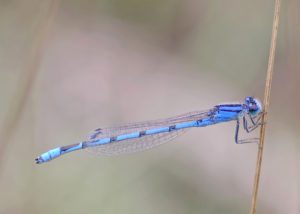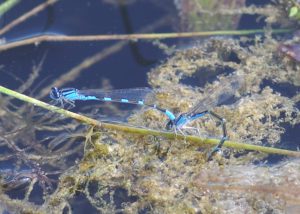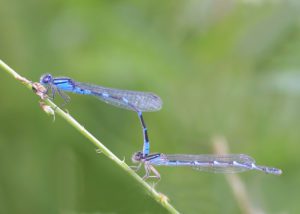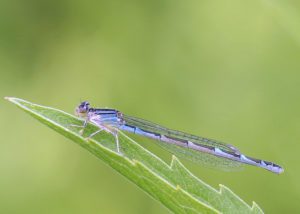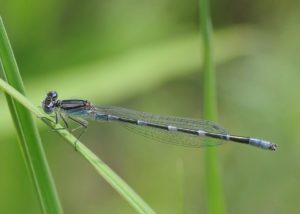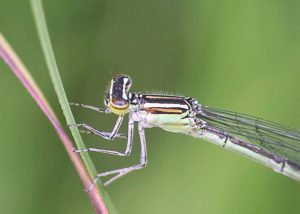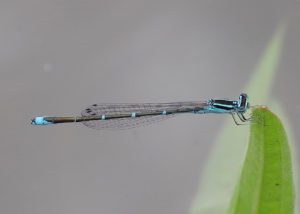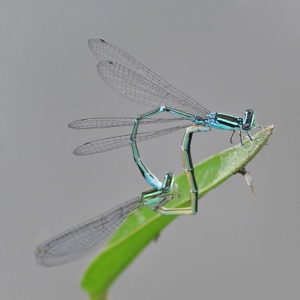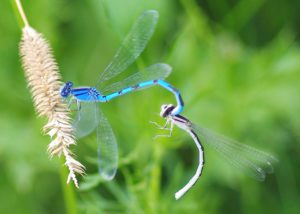Greetings, BugFans,
Seasoned BugFans know that the BugLady can’t go too long without writing about Odonates.
Quick review: Dragonflies and damselflies are in the order Odonata. Dragonflies tend to be bigger and bulkier than damselflies, with wrap-around eyes that touch at the top of the head in most families, and with wings that are held out at about 90 degrees at rest. Damselflies tend to be slimmer and smaller (though our longest damsels are longer than our smallest dragons), with eyes on the sides of their heads like a hammerhead shark, and with wings held over their backs or in a “V” at rest. They’ve been around for more than 250 million years.
Bluets are damselflies in the Narrow-winged/Pond Damsel family Coenagrionidae. As a group, the Narrow-winged damselflies are found near a variety of permanent, unpolluted wetlands with still-to-slow waters. They lay their eggs (mostly) in submerged vegetation, and their aquatic offspring, naiads (“nymphs,” if you must, but never “larvae”) clamber around in underwater debris or on plants, ambushing the small invertebrates that swim by. Adults are often found in or on the edges of stands of grasses, cattails, reeds, etc., where they are concealed from their predators (which include larger damselflies and dragonflies). They prey on flying insects, and their forays are usually short ones.
Coenagrionidae is a big family of small damselflies (3,000 species – 135 in North America), represented in Wisconsin by dancers, forktails, bluets and sprites. The BugLady wandered through the other genera of Pond damsels recently, and it took her breath away:
Red damsels – https://bugguide.net/node/view/402209/bgpage,
Black and white Damsels https://bugguide.net/node/view/241908/bgpage,
Aurora Damsels – https://bugguide.net/node/view/1616337/bgimage and https://bugguide.net/node/view/1309087/bgimage,
Painted Damsels – https://bugguide.net/node/view/1373017/bgpage,
Swamp Damsels – https://bugguide.net/node/view/1637415/bgpage,
Yellowfaces – https://bugguide.net/node/view/1638137/bgimage,
Firetails – https://bugguide.net/node/view/522811/bgimage,
and this little beauty – https://bugguide.net/node/view/916471/bgpage.
Road trip.
Many bluets are habitat generalists, but others are specialists. Although they’re sometimes found far from water, they mostly live near the wetland that produced them. Some male bluets are easy to identify, like this amazing Vesper Bluet (https://bugguide.net/node/view/437458/bgimage), but most are not, unless you have a net, and a hand lens with which to view the claspers/terminal appendages. Photographs are usually inadequate for the task, so the BugLady has a big collection of “bluet X” pictures and, because photographers like to label their pictures, she undoubtedly has some “hastily-identified” bluet pictures, too. Females, less flashy than males, can be even more confusing – they often come in a few color forms, and some individuals even have male coloration.
Visually (for “ease” in identification, not taxonomically) the three dozen or so species of bluets in the American bluet genus Enallagma are divided into four groups, based on the amount of blue on the male’s abdomen – “blue” bluets, “black” bluets, “intermediate” bluets, and “other” (in our neck of the woods, “other” means the dazzling Rainbow, Orange, and Vesper Bluets). Seventeen genus members occur in Wisconsin, plus two species of Eurasian bluets in the genus Coenagrion.
Remember – there isn’t any blue pigment. A bluet’s blue is “structural” – light bounces off special cells under the cuticle, and the wavelength our eye receives it as is aqua blue.
Without further ado, here are three common damsels that brighten the BugLady’s path from early-summer through mid-fall:
The TULE BLUET (Enallagma carunculatum) is found across the continent from southern Canada into Mexico near ponds, lakes of all sizes, and slow portions of streams, especially those with bulrushes growing along the edges. It can tolerate moderately salty or alkaline water and is most common in the first half of summer. Adults eat a lot of mayflies, and they sometimes pluck a sitting insect off its perch.
It’s a “mid-type bluet,” with narrow-but-noticeable blue rings around its abdomen. Female Tule Bluets are blue or tannish, and to the BugLady’s eye, their colors have a pearly finish.
Males defend territories near the water’s edge, and after mating, he continues to grip her while she oviposits in the stems of bulrushes and other emergent plants (“contact guarding”). Bob DuBois tell us in Damselflies of Minnesota, Wisconsin & Michigan that Tule Bluets are able to hybridize with Familiar Bluets and River Bluets.
[Etymological Aside: Tule (pronounced too-lee) is a common name given to several species of bulrushes that grow in marshes. According to Wikipedia, it comes from a Nahuatl/Aztec word (“tollin”) that was adopted by the Spanish during their conquest of Mexico and applied to similar plants they found in California wetlands in the 1500’s. The old California saying, “out in the tules” is akin to “out in the boondocks” (“boondock,” in turn, comes from a Tagalog/Philippine term for mountain or remote area).]
STREAM BLUETS (Enallagma exsulans) are “black-type bluets” that grace the edges of streams, rivers, and sometimes ponds starting in early summer (the BugLady photographed a female Stream Bluet at Spruce Lake Bog, and it took a few spins of her mental Rolodex to realize what she was looking at because – no stream). They’re found in the eastern half of the country and they can be abundant. DuBois says that they are “often found in the company of dancers (the damselfly variety of dancers, that is),” and that’s certainly true at Waubedonia Park where, at times, two out of every three damselflies seems to be either a Stream Bluet or a Powdered Dancer.
In a group where the females are often dull-colored, the lime green females with their tan/gold shoulder and eye stripes are spectacular. His 9th abdominal segment is all blue, and the 8th is blue with a dark “V-shaped” notch on top; unlike many female bluets, she also shows blue on the tip of her abdomen.
They have a remarkably long mating period for a damselfly, averaging 1 ¼ hour. Females often submerge completely while ovipositing in plant stems, sometimes for as long as 30 minutes – he may accompany her part way, but he usually releases her before he goes under.
The BugLady enjoys seeing FAMILIAR BLUETS (Enallagma civile) on her walks in late summer, after most other bluets have faded away. Although the size of this “blue-type bluet” is comparable to the other two (1 ¼” to 1 ½”), it seems “beefier,” and its claspers are distinctive enough to be recognizable in a photograph.
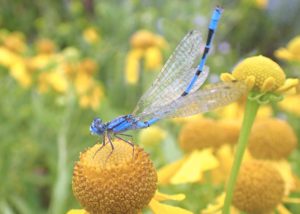
They like a variety of wetland types across most of the continent and throughout Central America. They are not picky about water quality, and they are inveterate colonizers of newly-formed wetlands.
Single males spend most of their time near the water, and females are unceremoniously snatched up by males if they approach the water’s edge. A tandem pair makes exploratory flights, looking for good habitat, before she oviposits. Beck and Bick, in an article in the Southwestern Naturalist in 1963, wrote that “One Familiar Bluet pair oviposited above the water for 158 minutes, then the female went underwater and oviposited there for another 15 minutes. One female ovipositing at the surface saw her guarding mate eaten by a Giant Water Bug, but continued to oviposit even after the bug finished eating the mate and made several attempts to seize her.”
Like those of the Tule and Stream Bluets, Familiar Bluet eggs hatch quickly, the youngsters grow fast, and they overwinter as late-stage naiads.
The BugLady gives Thanks for damselflies.
Kate Redmond, The BugLady
Bug of the Week archives:
http://uwm.edu/field-station/category/bug-of-the-week/

